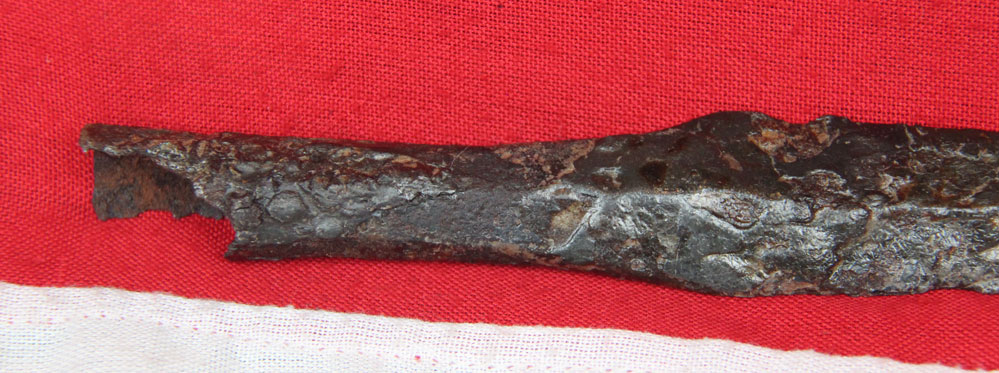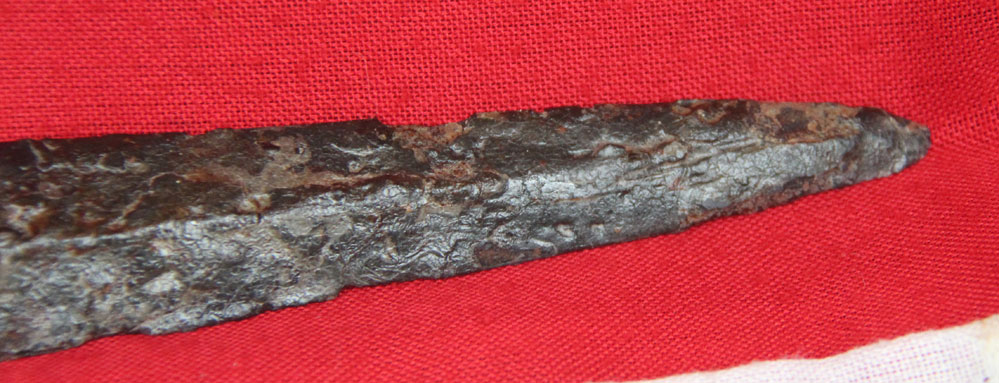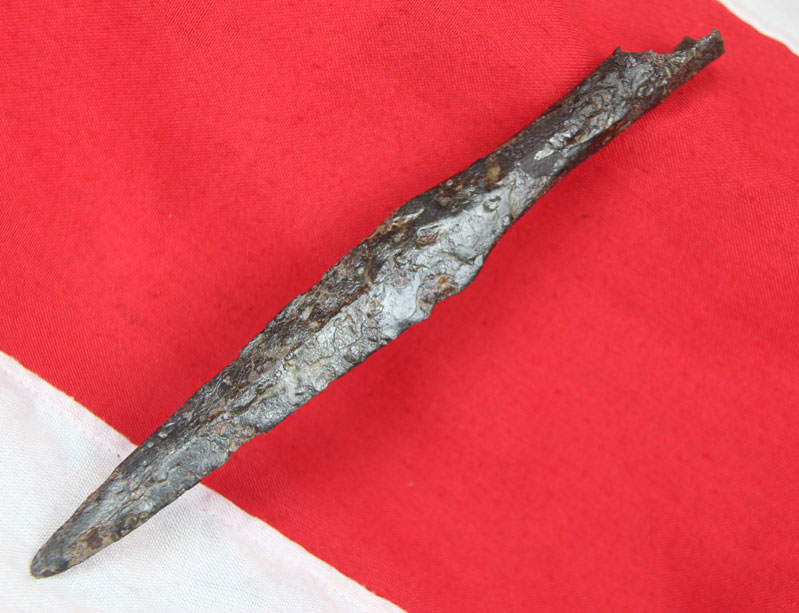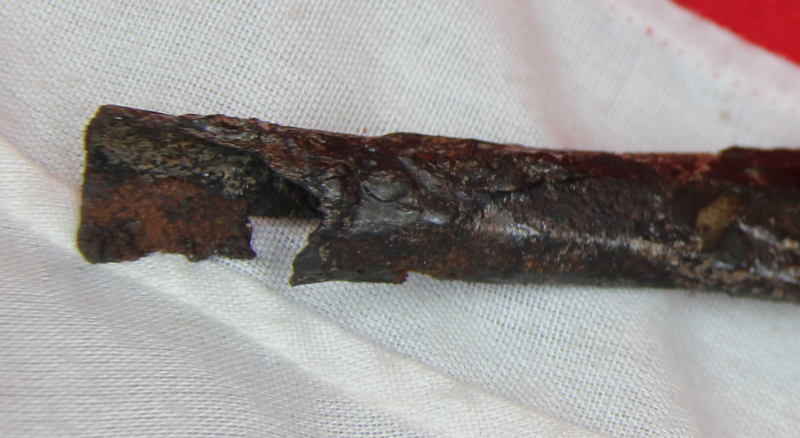A Heavy Grade 9th to 10th Century Original Viking Socket Spear. An Incredibly Inexpensive Original Viking Battle Spear From The Time of The Viking Seiges of Paris, And The Early Raids Into The British Isles
1100 to 1200 years old. The Viking spear, alongside the axe was the weapon of choice for the Viking warrior. The sword being the weapon of a high ranking Viking and Viking Jarl.
In the final decade of the eighth century, Viking raiders attacked a series of Christian monasteries in the British Isles. Here, these monasteries had often been positioned on small islands and in other remote coastal areas so that the monks could live in seclusion, devoting themselves to worship without the interference of other elements of society. At the same time, it made them isolated and unprotected targets for attack by sea. From 865, the Viking attitude towards the British Isles changed, as they began to see it as a place for potential colonisation rather than simply a place to raid. As a result of this, larger armies began arriving on Britain's shores, with the intention of conquering land and constructing settlements there.
The early Viking settlers would have appeared visibly different from the Anglo-Saxon populace, wearing Scandinavian styles of jewellery, and probably also wearing their own peculiar styles of clothing. Viking and Anglo-Saxon men also had different hairstyles: Viking men's hair was shaved at the back and left shaggy on the front, whilst the Anglo-Saxons typically wore their hair long.
The siege of Paris of 845 was the culmination of a Viking invasion of West Francia. The Viking forces were led by a Norse chieftain named "Reginherus", or Ragnar, who tentatively has been identified with the legendary saga character Ragnar Lodbrok. Reginherus's fleet of 120 Viking ships, carrying thousands of warriors, entered the Seine in March and sailed up the river.
Ragnar's Vikings raided Rouen on their way up the Seine in 845 and in response to the invasion, determined not to let the royal Abbey of Saint-Denis (near Paris) be destroyed, Charles assembled an army which he divided into two parts, one for each side of the river. Ragnar attacked and defeated one of the divisions of the smaller Frankish army, took 111 of their men as prisoners and hanged them on an island on the Seine to honour the Norse god Odin, as well as to incite terror in the remaining Frankish forces.
The Vikings reached Paris at the end of the month, during Easter. They plundered and occupied the city, withdrawing after Charles the Bald paid a ransom of 7,000 French livres 2,570 kg (83,000 ozt) in gold and silver.
Ragnar's fleet made it back to his overlord, the Danish King Horik I, but Ragnar soon died from a violent illness that also spread in Denmark
The spear is a pattern welded blade, and although now pitted as is most usual after over 1000 years it is a remarkable survivor of Viking combat warfare, and a remarkably inexpensive piece of original and legendary Viking weaponry, and thus extremely affordable. In chapter 55 of Laxdla saga, Helgi had a spear with a blade one ell long (about 50cm, or 20in). He thrust the blade through Bolli's shield, and through Bolli. In chapter 8 of Krka-Refs saga, Refur made a spear for himself which could be used for cutting, thrusting, or hewing. Refur split orgils in two down to his shoulders with the spear. The spearheads were made of iron, and, like sword blades, were made using pattern welding techniques (described in the article on swords) during the early part of the Viking era . They could be decorated with inlays of precious metals or with scribed geometric patterns
After forming the head, the smith flattened and drew out material to form the socket . This material was formed around a mandrel and usually was welded to form a solid socket. In some cases, the overlapping portions were left unwelded. Spear heads were fixed to wooden shafts using a rivet. The sockets on the surviving spear heads suggest that the shafts were typically round, with a diameter of 2-3cm (about one inch).
However, there is little evidence that tells us the length of the shaft. The archaeological evidence is negligible, and the sagas are, for the most part, silent. Chapter 6 of Gsla saga tells of a spear so long-shafted that a man's outstretched arm could touch the rivet. The language used suggests that such a long shaft was uncommon.
Perhaps the best guess we can make is that the combined length of shaft and head of Viking age spears was 2 to 3m (7-10ft) long, although one can make arguments for the use of spears having both longer and shorter shafts. A strong, straight-grained wood such as ash was used. Many people think of the spear as a throwing weapon. One of the Norse myths tells the story of the first battle in the world, in which Odin, the highest of the gods, threw a spear over the heads of the opposing combatants as a prelude to the fight. The sagas say that spears were also thrown in this manner when men, rather than gods, fought. At the battle at Geirvir described in chapter 44 of Eyrbyggja saga, the saga author says that Steinrr threw a spear over the heads of Snorrigoi and his men for good luck, according to the old custom. More commonly, the spear was used as a thrusting weapon. The sagas tell us thrusting was the most common attack in melees and one-on-one fighting, and this capability was used to advantage in mass battles. In a mass battle, men lined up, shoulder to shoulder, with shields overlapping. After all the preliminaries, which included rock throwing, name calling, the trading of insults, and shouting a war cry (aepa herop), the two lines advanced towards each other. When the lines met, the battle was begun. Behind the wall of shields, each line was well protected. Once a line was broken, and one side could pass through the line of the other side, the battle broke down into armed melees between small groups of men.
Before either line broke, while the two lines were going at each other hammer and tongs, the spear offered some real advantages. A fighter in the second rank could use his spear to reach over the heads of his comrades in the first rank and attack the opposing line. Konungs skuggsj (Kings Mirror), a 13th century Norwegian manual for men of the king, says that in the battle line, a spear is more effective than two swords. In regards to surviving iron artefacts of the past two millennia, if Western ancient edged weapons were either lost, discarded or buried in the ground, and if the ground soil were made up of the right chemical composition, then some may survive exceptionally well. As with all our items it comes complete with our certificate of authenticity. Approx 10 inches longAlmost every iron weapon that has survived today from this era is now in a fully russetted condition, as is this one, because only the swords of kings, that have been preserved in national or Royal collections are today still in a good state and condition.
Code: 22779
650.00 GBP








